Dental bridges replace missing teeth. They can restore chewing function, enhance your appearance and improve your oral health. A dental bridge consists of crowns (that fit over your natural teeth on either side of the space) and artificial teeth (that “bridge the gap” in your smile).
What is a dental bridge?
Dental bridges build a bridge between the two teeth close to the missing tooth location, restoring one or more missing teeth. The dentist will next need to file down the neighboring tooth’s enamel in order to accept a crown to link with the ceramic bridge.
In addition, if you’ve lost a lot of teeth, your dentist could first place the implant before putting in the dental bridge.
Numerous materials, including metal, titanium, ceramic, and porcelain, can be used to create bridges. Strengths and traits will vary depending on the kind.
Dental bridge vs Dental implant
Dental bridges are a particular kind of prosthetic appliance that are used to replace one or more missing teeth. They are often composed of metal, gold, silver, ceramic, or porcelain. Dental bridges are fixed to the teeth or to an implant that surrounds the empty area, and only a dentist is able to remove them. This is unlike removable prosthetic devices like dentures.
Abutment refers to the portion of a dental implant that is utilized to hold a bridge. Abutments act as the bridge’s anchor points. After that, the pontic, which serves as a substitute tooth, is affixed to the bridge that covers the abutments. If a dental implant is not utilized, a dental bridge is often attached by first smoothing the teeth’s surfaces to prepare them to accommodate the bridgework.
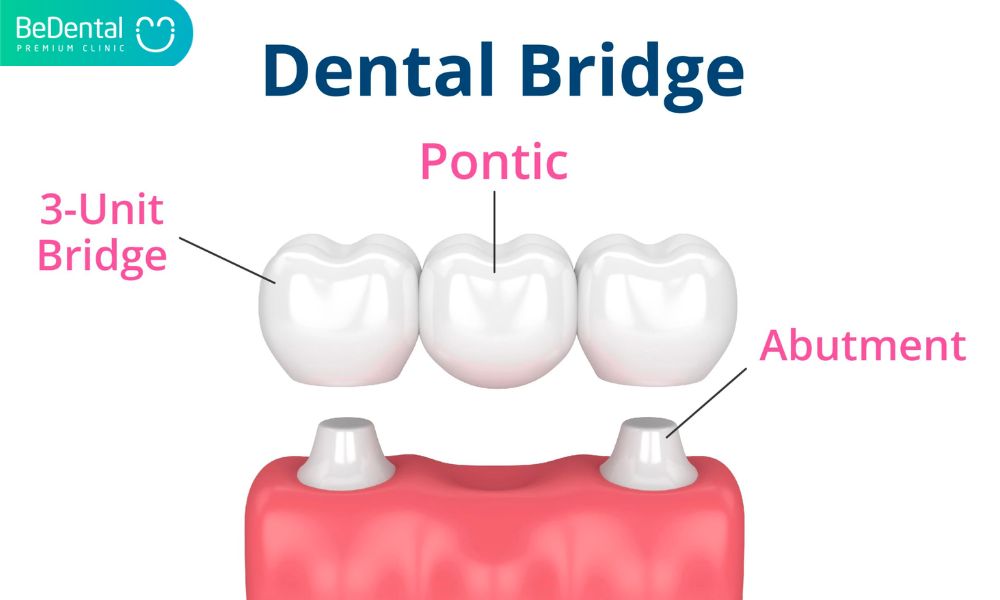
Dental bridges are available in three distinct varieties: traditional bridges, resin-bonded bridges, and cantilever bridges. The most prevalent kind of bridges are traditional bridges, which are often constructed of porcelain bonded to metal or ceramic materials.
The most typical type of material used to make crowns and bridges is porcelain. It is made of a substance with a tooth-like appearance that may be matched to the color of your natural teeth. Porcelain may be shaped to resemble the appearance of your natural tooth enamel and provide a solid base for your bridge.
See more: Root canal treatment
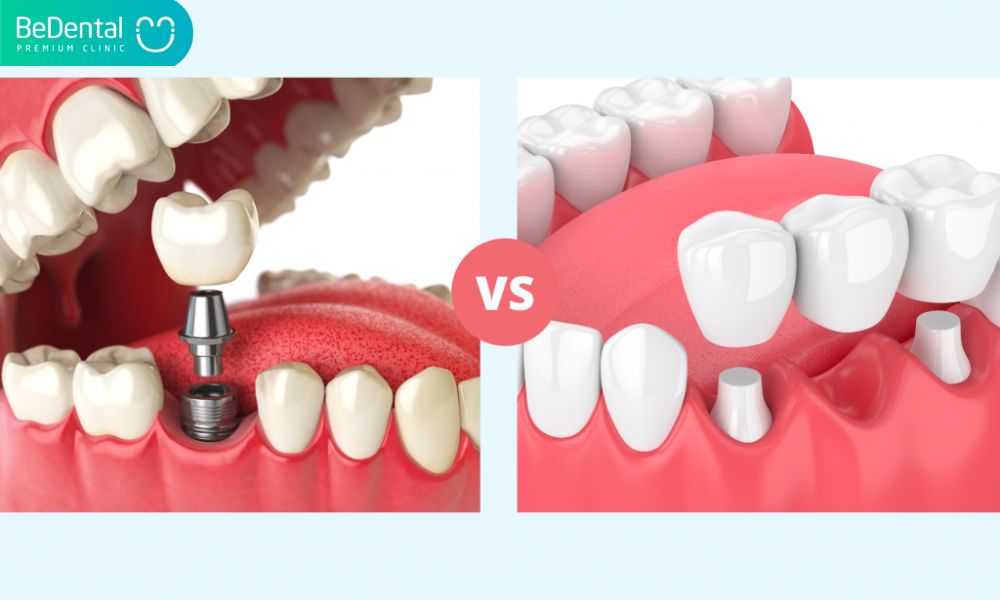
Dental porcelain is a sturdy type of bridge that can withstand everything you eat, just like strong, real teeth can. In addition, porcelain has a whiteness akin to that of glass that reflects light and gives the impression of actual tooth enamel. Dental bridges constructed of porcelain are good prosthesis because of their durability. Porcelain dental bridges are a practical and efficient technique to replace any lost teeth.
Although it’s commonly thought that using porcelain bridges is risk-free, there are some possible dangers to be aware of. Make sure to schedule a consultation with your cosmetic dentist and inquire about the safety measures for the particular dental bridge surgery you are thinking about having done.
See more: Dental crowns
Dental bridge types
There are four main types of dental bridges:
- traditional
- cantilever
- Maryland
- implant-supported

Traditional dental bridge
A traditional dental bridge comprises dental crowns that have been bonded to each of the abutment teeth holding a false tooth or teeth in place. The most common form of dental bridge is a conventional bridge, which can be utilized when you still have strong teeth on either side of the gap left by your lost tooth.
Cantilever dental bridge
Cantilever dental bridges are similar to traditional bridges in that just one abutment tooth serves as the anchor for the pontic, which is secured in place by a dental crown. You just need one healthy tooth next to the gap left by the lost tooth to support a cantilever bridge.
Maryland dental bridge
Maryland dental bridges use two healthy teeth as abutment teeth, one on either side of the gap, much like a conventional bridge would. A Maryland bridge employs a metal or porcelain framework that is bonded to the backs of the abutment teeth, as opposed to a typical bridge, which uses dental crowns on the abutment teeth.
A Maryland bridge may only be utilized, like a standard bridge, if there is a natural tooth on either side of the gap left by the lost tooth or teeth.
Implant-supported dental bridge
As the name suggests, implant-supported bridges rely on dental implants rather than frames or crowns. One implant is typically surgically inserted for each missing tooth, and this implant holds the bridge in place. A pontic may be hung between two implant-supported crowns if one implant for each lost tooth is not possible.
An implant-supported bridge, which is regarded as the strongest and most stable tool, often needs two operations:
- one to insert the implants in the jawbone
- a second surgery to place the bridge
The entire process may take many months to complete.
Dental Bridge’s Procedure Details
It depends on what type of dental bridge you receive:
Traditional or cantilever bridge
See more: Porcelain Veneers and 3 factors influence the price of Porcelain Veneers
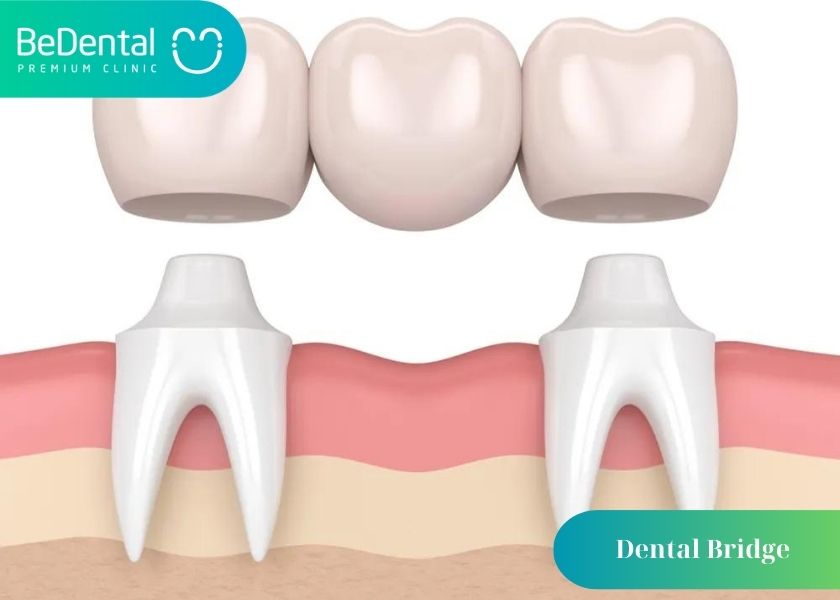
To place a traditional or cantilever bridge, your dentist will:
- Give you local anesthesia to keep you comfortable during your dental bridge procedure.
- Reshape your abutment teeth (the natural teeth that’ll support your new bridge). To do this, they’ll need to remove some tooth enamel. This step is irreversible.
- Take dental impressions and send them to a dental laboratory. There, a lab technician will use them to create your final bridge.
- Place a temporary bridge until a lab creates your final bridge. It usually takes about two to four weeks to make a dental bridge.
See more: Zirconia Prosthetics Used to Treat Cavities and Tooth Sensitivity
During a second office visit (once your final bridge is ready), your dentist will:
- Remove your temporary dental bridge.
- Try on your new final bridge and check the fit.
- Bond (cement) your new dental bridge in place.
Some dentists use CAD/CAM (computer-aided design and computer-aided manufacturing) technology to create custom bridges in their office during the same appointment. Ask your dentist if this is a possibility for you.
Maryland bridge
To place a Maryland bridge, your dentist will:
- Prepare your teeth for the metal wings.
- Take dental impressions and send them to a laboratory. (A lab technician will use these to make your final dental bridge.)
Once your final bridge is ready, your dentist will schedule a second office visit. During this appointment, they’ll:
- Try in your new Maryland bridge and check the fit.
- Apply dental etch to the back surfaces of your neighboring (abutment) teeth. This allows for bonding of the dental cement.
- Bond the wings of the Maryland bridge to the backs of your abutment teeth using dental resin cement.
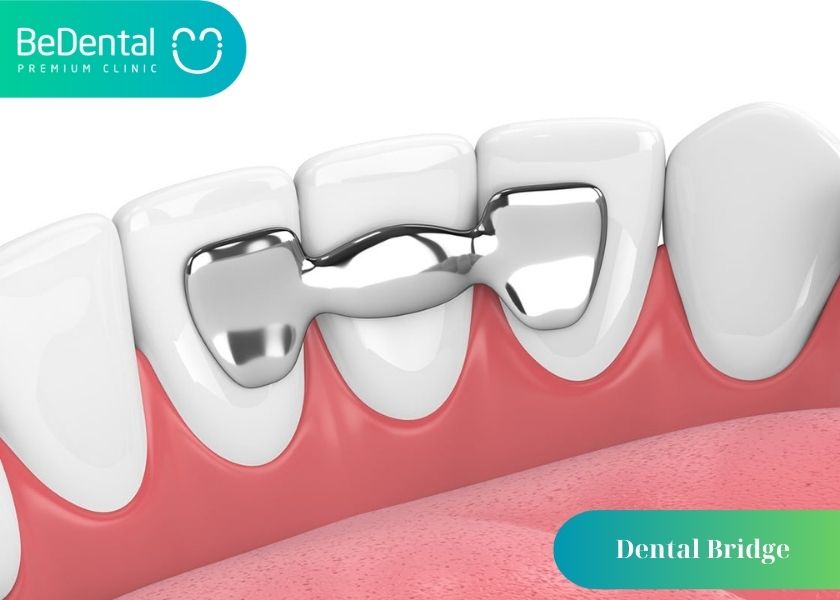
Implant-supported bridge
An implant-supported bridge requires several office visits, including one surgery appointment.
During the first appointment, a dentist, periodontist or oral surgeon will:
- Give you anesthesia to numb your mouth and keep you comfortable.
- Place dental implants into your jaw during an oral surgery procedure.
After surgery, your implants will need to heal and fuse to your jawbone (a process known as osseointegration). This process takes three to six months on average, but it could take longer depending on your situation.
See more: Dental implants and Dental bridge
Once your dental implants have integrated (fused), your dentist will:
- Attach impression copings to your dental implants and take dental impressions. (Impression copings are tiny connector posts that extend slightly beyond your gum line.)
- Take dental impressions with the copings in place. They’ll send the impressions to a dental lab.
- Remove the abutments while you wait for the lab to make your new implant-supported bridge.
Once your final implant-supported bridge is ready, your dentist will:
- Place the implant abutments and attached bridge to your dental implants and confirm the fit.
- Secure your bridge in place. Your dentist may use dental cement or tiny screws to do this. (It shouldn’t hurt, though.)
Because dental implants take a few months to integrate (fuse) with your jaw, implant-supported bridges take longer than other types of bridges.
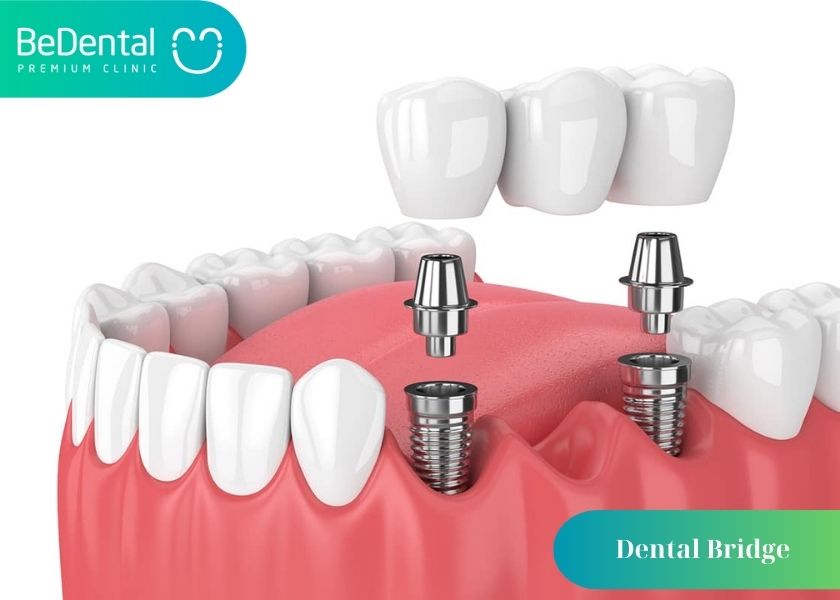
How Much for A Dental Bridge?
How Much for A Dental Bridge? There are several factor that can decide the price including:
- number of teeth needed to fill the gap
- materials used, such as composite resin, zirconia, or metal
- difficulty of the placement
- additional treatments
- geographic location
The price also changes depending on the bridge type you choose:
- One pontic and a crown for each abutment tooth are commonly included in traditional or cantilever bridge prices ranging from $2,000 to $5,000.
- Maryland bridges generally range in price from $1,500 to $2,500 for a single pontic with the wings linked to the abutment teeth.
- An implant-supported bridge could cost $5,000 – $15,000 for a bridge with two dental implants spanning three or four teeth.
In conclusion, if you ask How Much for A Dental Bridge? the answer may vary depends on your case. So, to have the best consultation, please contact a prestigious dental clinic for the best advice.
Here is BeDental’s price list for refer.
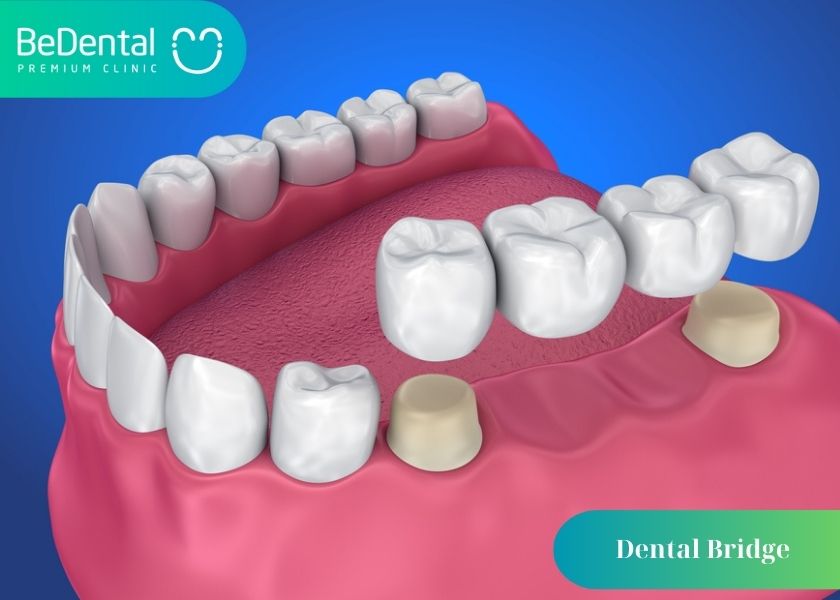
Q&A
What is better: a bridge or implant?
Dental bridges have a higher likelihood of being paid for by your insurance and come with a lower initial outlay. Dental implants could be a better choice if money isn’t a concern and your general health is good because they stay longer and don’t harm the nearby teeth.
Why is a bridge not recommended?
The jawbone will continue to degenerate because bridges are above the gum line. Implants endure a lifetime, whereas bridges don’t. Bridges have a maximum life of roughly 15 years; dental implants are anticipated to last more than 25 years.
Which is the less painful bridge or implant?
Choosing a dental bridge has a few benefits. Surgery is not necessary for this straightforward treatment (unlike implants). Because of this, getting a bridge is far less painful than receiving an implant. Additionally, the process is pretty rapid.
See more: Dentures and 2 types of dentures
Why does a doctor prefer bridge over implant?
A dental bridge might be preferred over an implant in cases when you have two damaged teeth close to the missing tooth. This is because those teeth require crowns for further security. When it comes to changing the color of more than two teeth at a lower cost, bridges are more adaptable.
What is the disadvantage of bridge?
Tooth decay develops behind a bridge that doesn’t fit properly. To make room for the dental crowns during the preparation, your abutment teeth are weakened. If your abutment teeth lack the necessary strength, the restoration may collapse.
Do bridges weaken teeth?
For traditional dental bridges, natural teeth must be covered with crowns. There will be some good tooth enamel lost during the shaving down and capping of the healthy teeth on each side of the bridge. This raises the possibility of causing already healthy teeth irreparable harm.
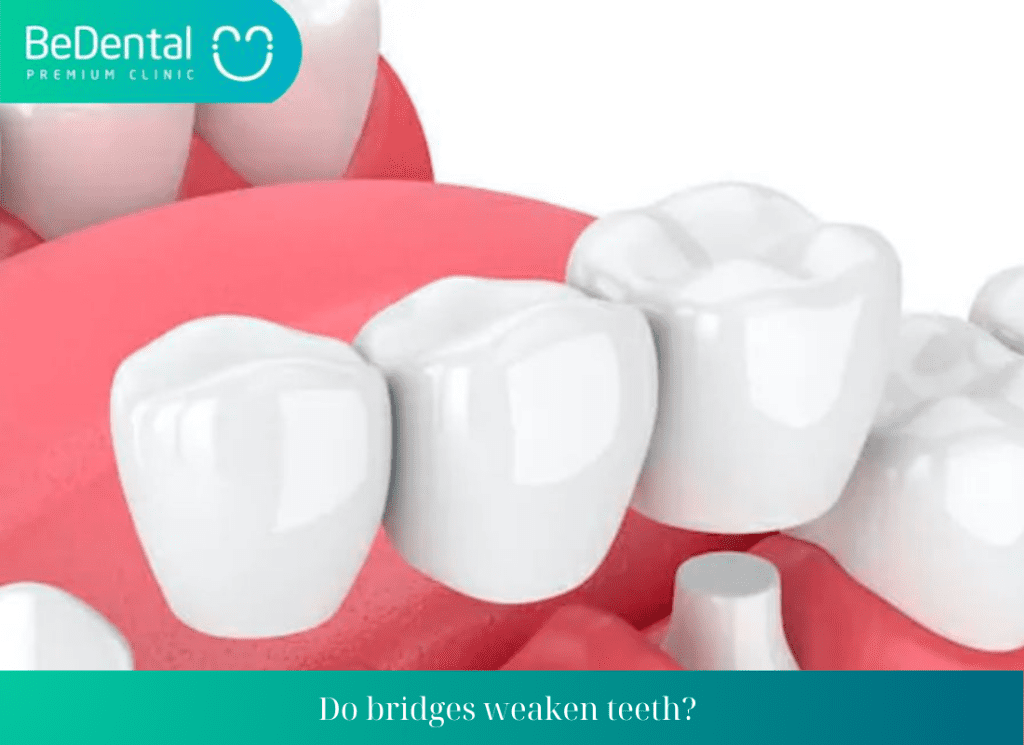
See more: Dental Implants and Dental Bridges: What is the difference?



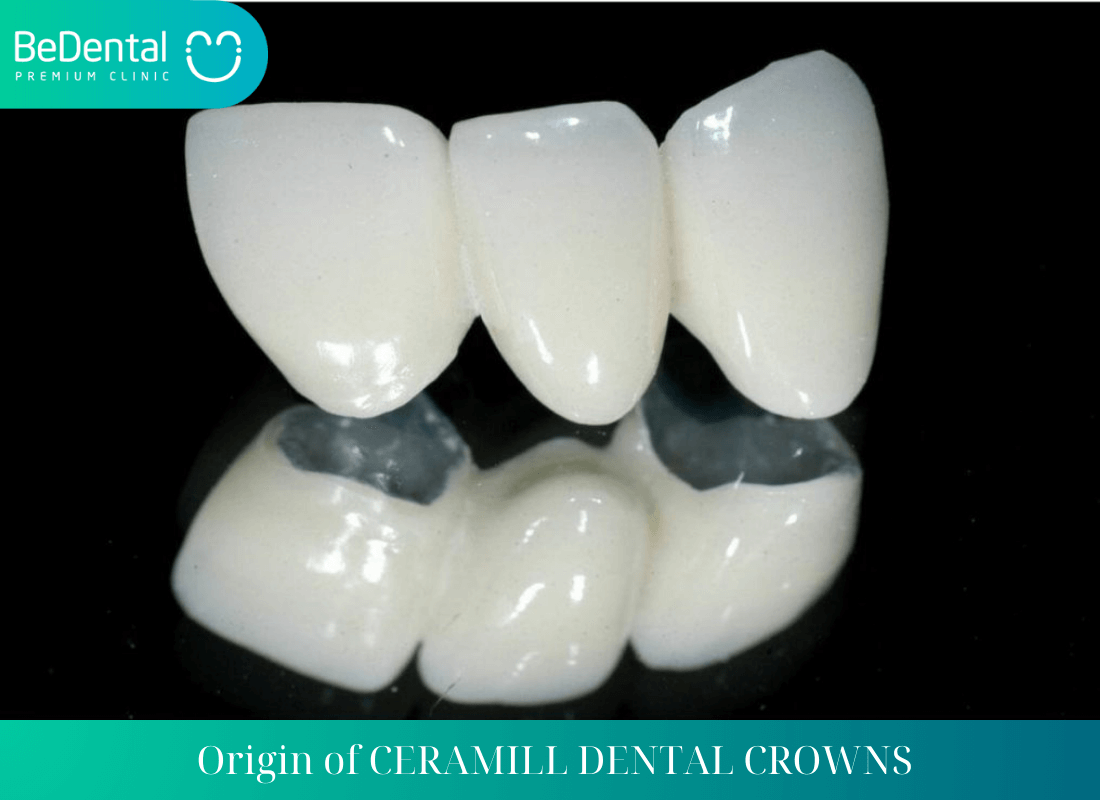


Pingback: The Purpose, Risks, and 4 Steps of Dental X-Rays that You Should Know – Be Dental
Pingback: Zirconia Prosthetics Used to Treat Cavities and Tooth Sensitivity – Be Dental
Pingback: Bad Breath and 6 Common Questions – Be Dental
Pingback: Zirconia Bridge and 5 Tips Should Know – Be Dental